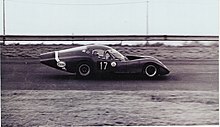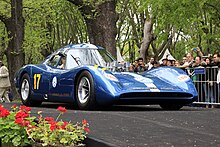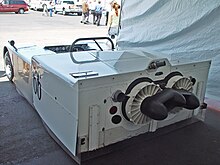Ground effect (cars)
In car design, ground effect is a series of effects which have been exploited in automotive aerodynamics to create downforce, particularly in racing cars. This has been the successor to the earlier dominant aerodynamic focus on streamlining. The international Formula One series and American racing IndyCars employ ground effects in their engineering and designs. Similarly, they are also employed in other racing series to some extent; however, across Europe, many series employ regulations (or complete bans) to limit its effectiveness on safety grounds.
Theory
In racing cars, a designer's aim is for increased downforce and grip to achieve higher cornering speeds. A substantial amount of downforce is available by understanding the ground to be part of the aerodynamic system in question, hence the name "ground effect". Starting in the mid-1960s,
This kind of ground effect is easily illustrated by taking a tarpaulin out on a windy day and holding it close to the ground: it can be observed that when close enough to the ground the tarp will be drawn towards the ground. This is due to Bernoulli's principle; as the tarp gets closer to the ground, the cross sectional area available for the air passing between it and the ground shrinks. This causes the air to accelerate and as a result pressure under the tarp drops while the pressure on top is unaffected, and together this results in a net downward force. The same principles apply to cars.
The Bernoulli principle is not the only aspect of mechanics in generating ground-effect downforce. A large part of ground-effect performance comes from taking advantage of viscosity. In the tarp example above, neither the tarp nor the ground is moving. The boundary layer between the two surfaces works to slow down the air between them which lessens the Bernoulli effect. When a car moves over the ground, the boundary layer on the ground becomes helpful. In the reference frame of the car, the ground is moving backwards at some speed. As the ground moves, it pulls on the air above it and causes it to move faster.[dubious ] This enhances the Bernoulli effect and increases downforce. It is an example of Couette flow.
While such downforce-producing aerodynamic techniques are often referred to with the catch-all term "ground effect", they are not strictly speaking a result of the same aerodynamic phenomenon as the
History


American
In 1968, the argentine designer and engineer, Heriberto Pronello, developed the Pronello Huayra-Ford for the Sport Prototipo Argentino category,[2] making its first appearance in Córdoba for the 1969 season with Carlos Reutemann and Carlos Pascualini as drivers.
During 1968, a 1/5 scale model was made, which was tested in the wind tunnel of the Fábrica Militar de Aviones (FMA) usually employed by the Argentine Air Force, demonstrating the functionality of the ground effect at that scale. In 2023, the Pronello Huayra chassis #002 was invited to the Goodwood Festival Of Speed. During its stay in England, the car was taken to the Catesby tunnel, where a complete aerodynamic analysis was carried out by the argentine engineer and professor Sergio Rinland.
"We always thought it had ground effect... When Heriberto tested it at the National University of Córdoba, he verified its air resistance with a 1/5 scale model that was perfect, without door and hood openings, without the intake turrets..." Rinland said.[3]
“The tests we did in the Catesby Tunnel demonstrated its great aerodynamic efficiency: we obtained a Cx 0.25 with the short tail and a Cx 0.23 with the long tail, which it used on the fastest circuits. Almost, almost what Heriberto had measured at the time”[4]
“It has a slippery upper shape and a flat floor with a diffuser that gave it quite an edge in its day. The diffuser has an expansion ratio that puts it staggeringly close to the maximum downforce you can get from a diffuser. The car was at the tunnel with pressure tapings added to it, in order to look at the pressure distribution around the car which looks to completely confirm that it works exactly as the designer expected.”, explained Willem Toet. These tests were carried out with and without the "long tail" which was used for high-speed circuits, with the vehicle propelled by its own means, at working temperature, returning consistent and repeatable results.[5][6]


At about the same time, Shawn Buckley began his work in 1969 at the University of California, Berkeley on undercar aerodynamics sponsored by Colin Chapman, founder of Formula One Lotus. Buckley had previously designed the first high wing used in an IndyCar, Jerry Eisert's "Bat Car" of the 1966 Indianapolis 500. By proper shaping of the car's underside, the air speed there could be increased, lowering the pressure and pulling the car down onto the track. His test vehicles had a Venturi-like channel beneath the cars sealed by flexible side skirts that separated the channel from above-car aerodynamics. He investigated how flow separation on the undersurface channel could be influenced by boundary layer suction and divergence parameters of the underbody surface.[7][8][9] Later, as a mechanical engineering professor at MIT, Buckley worked with Lotus developing the Lotus 78.
On a different tack, Brabham designer Gordon Murray used air dams at the front of his Brabham BT44s in 1974 to exclude air from flowing under the vehicle. Upon discovering that these tended to wear away with the pitching movement of the car, he placed them further back and discovered that a small area of negative pressure was formed under the car, generating a useful amount of downforce - around 70 kg (150 lb). McLaren produced similar underbody details for their McLaren M23 design.[1]
In 1977 Rudd and Wright, now at Lotus, developed the
After a forty-year ban, ground effect returned to Formula 1 in 2022 under the latest set of regulation changes.
The effect was used in its most effective form in IndyCar designs. IndyCars did not use ground effect as substantially as Formula One. For example, they lacked the use of skirts to seal off the underbody of the car. IndyCars also rode higher than ground effect F1 cars and relied on wings for significant downforce as well, creating an effective balance between over the car downforce and ground effect.
Porpoising
"Porpoising" is a term commonly used to describe a particular fault encountered in ground-effect racing cars. Racing cars had only been using their bodywork to generate downforce for just over a decade when Colin Chapman's Lotus 78 and 79 cars demonstrated that ground effect was the future in Formula One, so, at this point, under-car aerodynamics were still very poorly understood. To compound this problem the teams that were very keen to pursue ground effects tended to be the more poorly funded British "garagiste" teams, who had little money to spare for wind tunnel testing, and tended simply to mimic the front-running Lotuses (including the Kauhsen and Merzario teams).[citation needed]
This led to a generation of cars that were designed as much by hunch as by any great knowledge of the finer details, making them extremely pitch-sensitive. As the centre of pressure on the sidepod aerofoils moved about depending on the car's speed, attitude, and ground clearance, these forces interacted with the car's suspension systems, and the cars began to resonate, particularly at slow speeds, rocking back and forth - sometimes quite violently. Some drivers were known to complain of sea-sickness.[citation needed] This rocking motion, like a porpoise diving into and out of the sea as it swims at speed, gives the phenomenon its name. These characteristics, combined with a rock-hard suspension, resulted in the cars giving an extremely unpleasant ride. Ground effects were largely banned from Formula One in the early 1980s until 2022, but Group C sportscars and other racing cars continued to suffer from porpoising until better knowledge of ground effects allowed designers to minimise the problem.[15] At the first pre-season test in Barcelona ahead of the 2022 Formula One World Championship, George Russell said extreme porpoising could lead to safety issues and later stated he was suffering from chest pain due to extreme porpoising during the 2022 Emilia Romagna Grand Prix. At the 2022 Azerbaijan Grand Prix, Lewis Hamilton struggled to get out of the car after the race due to violent porpoising.[16][17]
See also
- Automotive aerodynamics
- Formula One car
- Ground effect in aircraft
- Ground-effect train
- Venturi effect
References
- ^ a b c Nye 1985, p. 94
- ^ Automundo, Viejas (8 April 2013). "Viejas Automundo: Revista Automundo Nº 154 - 16 Abril 1968". Viejas Automundo. Retrieved 2024-04-17.
- ^ Autocosmos (2023-07-17). "Pronello Huayra Ford: el primer auto de competición con efecto suelo del mundo". Autocosmos (in Spanish). Retrieved 2024-04-17.
- ^ "Pronello Huayra Ford: el primer auto de competición con efecto suelo del mundo". AUTOMUNDO (in Spanish). 2023-07-16. Retrieved 2024-04-17.
- ^ Brook-Jones, Callum (2023-07-26). "Huayra Pronello-Ford tested in Catesby Tunnel ahead of Goodwood FOS". Automotive Testing Technology International. Retrieved 2024-04-17.
- ^ "Huayra Pronello Ford: Argentinian sensation | Classic & Sports Car". www.classicandsportscar.com. Retrieved 2024-04-17.
- ^ S. Buckley, "Vehicle Surface Interaction" Ph.D. Dissertation, University of California - Berkeley, Sept., 1972
- ^ B. Shawn Buckley, "Road Test Aerodynamic Instrumentation", SAE paper 741030, 1974-02-01
- ^ B. Shawn Buckley, Edmund V. Laitone, "Air Flow Beneath an Automobile", SAE paper 741028, 1974-02-01
- ^ Nye 1985, p. 96
- ^ Nye 1985, p. 130
- ^ 8W - Why? - Brabham BT46B
- ^ Henry 1985, pp. 186–187
- ^ Nye 1985, p. 33
- ^ Elleray, Peter. "Mulsanne's Corner: Peter Elleray on the Bentley LMGTP". Mulsanne's Corner. Retrieved 2017-10-21.
- ^ Mitchell, Scott (24 February 2022). "F1 2022 car porpoising 'safety concern' at its worst". The Race. The Race Media. Retrieved 24 February 2022.
- ^ "George Russell reveals chest pain from Mercedes porpoising at Emilia Romagna GP". The Independent. 2022-04-25. Retrieved 2022-04-27.
- Henry, Alan (1985), Brabham, the Grand Prix Cars, Osprey, ISBN 0-905138-36-8
- Nye, Doug (1985), Autocourse History of the Grand Prix car 1966–1985, Hazleton publishing, ISBN 0-905138-37-6
